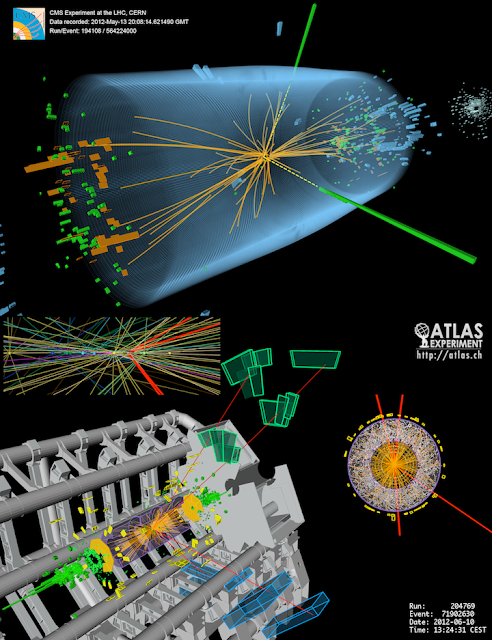#Our_Royal_Team_Visiting_Kanchrapara
https://plus.google.com/app/basic/photos/114655131120796363634/album/6065837932583779201?cbp=1ohjdruthdz4f&sview=1&cid=5&soc-app=115&soc-platform=1&spath=%
"Some of the brightest minds in the country can be found on the last benches of the classroom" Dr. A. P. J. Abdul Kalam
Friday 3 October 2014
Tuesday 30 September 2014
Higgs boson
The Higgs boson or Higgs particle is an elementary particle in the Standard Model of Particle physics. Its main relevance is that it is the smallest possible excitation of the Higgs field– a field that unlike the more familiar electromagnetic field cannot be "turned off", but instead takes a constant value almost everywhere. The presence of this field explains why some fundamental particles have mass while the symmetries controlling their interactions should require them to be massless, and why the weak force has a much shorter range than the electromagnetic force.
Despite being present everywhere, the existence of the Higgs field has been very hard to confirm, because it is extremely hard to create excitations (i.e. Higgs particles). The search for this elusive particle has taken more than 40 years and led to the construction of one of the world's most expensive and complex experimental facilities to date, the Large Hadron Collider, able to create Higgs bosons and other particles for observation and study. On 4 July 2012, the discovery of a new particle with a mass between 125 and 127 GeV/c2 was announced; physicists suspected that it was the Higgs boson. By March 2013, the particle had been proven to behave, interact and decay in many of the ways predicted by the Standard Model, and was also tentatively confirmed to have positive parity and zero spin,[1] two fundamental attributes of a Higgs boson. This appears to be the first elementary scalar particle discovered in nature. More data is needed to know if the discovered particle exactly matches the predictions of the Standard Model, or whether, as predicted by some theories, multiple Higgs bosons exist.
The Higgs boson is named after Peter Higgs, one of six physicists who, in 1964, proposed the mechanism that suggested the existence of such a particle. Although Higgs's name has come to be associated with this theory, several researchers between about 1960 and 1972 each independently developed different parts of it. In mainstream media the Higgs boson has often been called the "God particle", from a 1993 book on the topic; the nickname is strongly disliked by many physicists, including Higgs, who regard it as inappropriate sensationalism. On December 10, 2013 two of the original researchers, Peter Higgs and François Englert, were awarded the Nobel Prize in Physics for their work and prediction.Englert's co-researcher Robert Brout had died in 2011 and the Nobel Prize is not given posthumously except in unusual circumstances.
In the Standard Model, the Higgs particle is a boson with no spin, electric charge, or color charge. It is also very unstable, decaying into other particles almost immediately. It is a quantum excitation of one of the four components of the Higgs field. The latter constitutes a scalar field, with two neutral and two electrically charged components, and forms a complex doublet of the weak isospin SU(2) symmetry. The field has a "Mexican hat" shaped potential with nonzero strength everywhere (including otherwise empty space), which in its vacuum state breaks the weak isospin symmetry of the electroweak interaction. When this happens, three components of the Higgs field are "absorbed" by the SU(2) and U(1) gauge bosons (the "Higgs mechanism") to become the longitudinal components of the now-massive W and Z bosons of the weak force. The remaining electrically neutral component separately couples to other particles known as fermions (via Yukawa couplings), causing these to acquire mass as well. Some versions of the theory predict more than one kind of Higgs fields and bosons. Alternative "Higgsless" models would have been considered if the Higgs boson was not discovered.
Wednesday 24 September 2014
India created history on Wednesday, becoming the first country to successfully get a spacecraft into the Martian orbit on its maiden attempt. Indian Space Research Organisation's Mars Orbiter Mission (MOM) spacecraft started orbiting the red planet at 7.47am, but it was only 12 minutes later —because of a time delay in radio signals travelling the 680 million km -- that scientists at Isro Telemetry, Tracking and Command Network in Bangalore, could erupt in joy as Prime Minister Narendra Modi stood a happy witness. For most of the time the main engine was firing — 20 of the 24 crucial minutes — MOM was hiding behind Mars, adding to the suspense. The scientists had waited for more than 300 days as MOM journeyed on through space, but the last 54 minutes were virtually unbearable. For, it was during this period that the orbiter first reoriented itself and then fired its engine and thrusters for about 24 minutes to get into the Mars orbit.
India created history on Wednesday, becoming the first country to successfully get a spacecraft into the Martian orbit on its maiden attempt.
Indian Space Research Organisation's Mars Orbiter Mission (MOM) spacecraft started orbiting the red planet at 7.47am, but it was only 12 minutes later —because of a time delay in radio signals travelling the 680 million km -- that scientists at Isro Telemetry, Tracking and Command Network in Bangalore, could erupt in joy as Prime Minister Narendra Modi stood a happy witness.
For most of the time the main engine was firing — 20 of the 24 crucial minutes — MOM was hiding behind Mars, adding to the suspense.
The scientists had waited for more than 300 days as MOM journeyed on through space, but the last 54 minutes were virtually unbearable. For, it was during this period that the orbiter first reoriented itself and then fired its engine and thrusters for about 24 minutes to get into the Mars orbit. For all the action at the ground station, there was not much the scientists had to do. More than 10 days ago, they had uplinked all the commands for the manoeuvres to the spacecraft. MOM, like an obedient child, carried them out perfectly.
Prime Minister Narendra Modi congratulated the Isro scientists over the success.
"MOM never disappoints," he told applauding scientists at the Isro Telemetry, Tracking and Command Network in Bangalore.
"India is the first country to get this right in the first attempt," he said.
Modi turned philosophical while talking about the scientific achievement. "Jab kaam mangal hota hai, irade mangal hote hain, tho yaatra bhi mangal hota hai (When the task is holy, and so is the intention, the journey has to be a success)," he said.
Congratulating and prodding on Indian space scientists, he went on: "Unless you enter the waters you don't learn to swim. Risk tho lena hi padtha hai (You have to take risks," he said. He urged the scientists to continue to inspire the future generation. "Despite our many limitations, we have succeeded. It is a shining symbol of what we are capable of as a nation ... A successful space programme generates efforts across multiple domains," Modi said.
Switching between English and Hindi, the Prime Minister said the scientists were changing our lives and speed of achievement.
For many months -- if not years -- MOM will remain a satellite of Mars, clicking pictures and sniffing out details on the atmosphere and morphology of the red planet.
Through its journey since November 5, 2013 when PSLV-C25 lifted off from Sriharikota with the spacecraft in its nosecone, MOM has had a perfect journey. The first litmus test came on Monday when it was to carry out time-tagged commands to reignite its main engine which had been idling for about 300 days since it left the Earth orbit on December 1, 2013. MOM did this in style, burning for the designated four seconds to show that the engine is in fine shape. On Wednesday, it proved its resilience. As it goes around Mars on an elliptical orbit with the closest point around 420km and the farthest around 80,000km, MOM will employ five equipment that collectively weight 15kg to do scientific studies.
The Lyman alpha photometer would measure the relative abundance of deuterium and hydrogen in the upper Martian atmosphere to understand previous presence of water on the red planet. A methane sensor will look for sources of the gas. While the Mars colour camera clicks away, a thermal infrared spectrometer will study heat emission, minerals and soil on Mars.
Before India, various countries have launched Mars missions, but out of the 51 attempts, only 21 were successful. India now joins the Martian club that comprises the US, Russia and the European Space Agency. Only the European Space Agency has got its orbiter right in the first attempt (Mars Express in 2003), but India can claim a first since the agency is a conglomeration of several countries.
প্রথম বারেই লক্ষ্যভেদ, মঙ্গল-কক্ষে মঙ্গলযান
প্রথম বারেই লক্ষ্যভেদ, মঙ্গল-কক্ষে মঙ্গলযান
‘মম-এর আজ মঙ্গলের সঙ্গে মিলন হল এবং মঙ্গল পেয়ে গেল মম-কে।’ মঙ্গলের কক্ষপথে ভারতের মহাকাশ গবেষণা সংস্থার (ইসরো) মঙ্গলযান ‘মম’ (মার্স অরবিটার মিশন) পৌঁছনোর পর এ কথাই বললেন প্রধানমন্ত্রী নরেন্দ্র মোদী।
বুধবার সকালেই এসেছিল সুসংবাদ। সৌজন্যে ইসরো। ইতিহাস তৈরি করে লাল গ্রহের কক্ষে পৌঁছয় ইসরোর মঙ্গলযান। প্রথম চেষ্টাতেই সাফল্য পেলেন ভারতীয় বিজ্ঞানীরা। এ দিন সকালে অভূতপূর্ব এই সাফল্যের সাক্ষী রইলেন প্রধানমন্ত্রী। ইসরোকে অভিনন্দন জানিয়েছে নাসাও। কয়েক দিন আগেই তাদের যান ‘মাভেন’ও পৌঁছেছে মঙ্গল-কক্ষে। তবে সেই যানের থেকে অনেক কম খরচে ভারতীয় মঙ্গলযানের এই সাফল্য বিস্মিত করেছে গোটা বিশ্বকে। ৪৫০ কোটির এই মঙ্গলাভিযান আগের বছরের অস্কার প্রাপ্ত ছবি ‘গ্রাভিটি’র থেকেও সস্তায় সারা গিয়েছে। প্রধানমন্ত্রী নরেন্দ্র মোদী ইসরোকে অভিনন্দন জানিয়ে এ দিন বলেন, ‘‘আজকের সাফল্য আশা করি আমাদের আরও উজ্জিবীত করবে। আমরা আরও বড় লক্ষ্য ঠিক করব।’’ তিনি জানান, প্রাক্তন প্রধানমন্ত্রী অটলবিহারী বাজপেয়ী চাঁদে অভিযানের স্বপ্ন দেখেছিলেন। তা সফল হয়েছে। সেই সাফল্যই আজকের পথ খুলে দিয়েছিল। এ দিনের পর অন্য কোনও নতুন দিগন্ত উন্মোচিত করে বলে আশাপ্রকাশ করেন তিনি।
প্রথমে চন্দ্রযান। তার পরে মঙ্গলযান। পর পর সাফল্যে ঝুলি ভরে উঠেছে ইসরো-র। এ বার চিনকেও পিছনে ফেলে দিল ভারত। প্রায় দশ মাস যাত্রার পর এ দিন ছিল মঙ্গলযানের কাছে সবচেয়ে গুরুত্বপূর্ণ। মাত্র ২৪ মিনিট! এত দিন নির্দিষ্ট পথে চলার পরে এইটুকু সময়ের উপরেই দাঁড়িয়ে ছিল সাফল্য-ব্যর্থতার মানদণ্ড। মহাশূন্যে ছুটে চলা ভারতের মঙ্গলযানকে লাল গ্রহের কক্ষপথে বসাতে প্রয়োজন ছিল ওইটুকু সময়। এবং এই সময়টুকু কাটল একেবারে পরিকল্পনামাফিক। প্রথম অভিযানেই সাফল্যের বিরল কৃতিত্ব পেল ইসরো। এর আগে আমেরিকা, রাশিয়া বা ইওরোপীয় মহাকাশ গবেষণা সংস্থা প্রথম চেষ্টায় মঙ্গলের কক্ষপথে পৌঁছতে পারেনি। প্রতিশ্রুতি মতোই প্রধানমন্ত্রী এই অভিযানের চূড়ান্ত মুহূর্তে ইসরো-র পাশে ছিলেন।
Semester Question Papers for Computer Science and Engineering Students 2020 - 2021 | Computer Science and Engineering | MAKAUT | WBUT | Maulana Abul Kalam Azad University of Technology
Computer Science and Engineering 3rd Semester Question Papers Download Question Papers o...
-
W.B.C.H.S.E 11(XI) HIGHER SECONDARY EXAM 2016 EXAM QUESTIONS PDF W.B.C.H.S.E 11(XI) 2016 (2015-2016) EXAM QUESTIONS PDF (*PHYSICS*,*MA...
-
Physics Practical Copy 1 & Copy 2 Class 11 (XI) PDF Download Physics Practical Copy 1 & Copy 2 Class 11 (XI) West Bengal Cou...
-
Questions Papers All Subjects of 3rd Semester The year 2015, 2016,2017 Diploma (Polytechnic) Computer Science & Technology ...





